Students looking for the Bridges in Mathematics Grade 5 Student Book Answer Key Unit 2 Module 1 can find a better approach to solve the problems.
Bridges in Mathematics Grade 5 Student Book Answer Key Unit 2 Module 1
Bridges in Mathematics Grade 5 Student Book Unit 2 Module 1 Session 1 Answer Key
Money & Fractions
Note: You can use the money value pieces to help solve these problems if you like.
Question 1.
Write each amount as a decimal.
a. 2 quarters = _____
b. 3 dimes and 5 pennies = _____
Answer:
a. 2 quarters = 0.5
b. 3 dimes and 5 pennies = 0.35
Explanation:
We know that,
1 quarter = 25 cents.
So, 2 quarters = 50 cents.
$1 = 100 cents.
50 cents in decimals = 0.5
We know that,
1 dime = 10 cents and 1 penny = 1 cent.
So, 3 dimes and 5 pennies = 3 x 10 + 5 x 1 = 35 cents.
$1 = 100 cents.
35 cents in decimals = 0.35
Question 2.
Write each amount as a fraction of a dollar.
a. 3 quarters = _____
b. 7 dimes = _____
Answer:
a. 3 quarters = $ \(\frac{3}{4}\)
b. 7 dimes = $\(\frac{7}{10}\)
Explanation:
We know that,
1 quarter = 25 cents.
3 quarters = 75 cents.
$1 = 100 cents.
75 cents in fraction = \(\frac{75}{100}\) or \(\frac{3}{4}\)
We know that,
1 dime = 10 cents
7 dimes 7 x 10 = 70 cents.
So, fraction of 7 dimes in dollars = \(\frac{70}{100}\) or \(\frac{7}{10}\)
Question 3.
Use numbers, labeled sketches, or words to show your work.
a. Mila has \(\frac{1}{2}\) of a dollar. Claire has \(\frac{1}{4}\) of a dollar. How much money do the girls have together? Record your answer as a fraction and as a decimal.
Answer:
\(\frac{3}{4}\) and 0.75
Explanation:
Given that,
Mila has \(\frac{1}{2}\) of a dollar.
Claire has \(\frac{1}{4}\) of a dollar.
Total money do the girls have together, \(\frac{1}{2}\) + \(\frac{1}{4}\)
Take the L.C.M for 2 and 4 as 4.
\(\frac{(1 × 2) + (1 × 1)}{4}\)= \(\frac{2 + 1}{4}\) = \(\frac{3}{4}\) dollars.
Answer as a decimal = 0.75.
b. Henry has 1\(\frac{1}{4}\) dollars. Angel has 1\(\frac{1}{2}\) dollars. How much money do the boys have together? Record your answer as a fraction and as a decimal.
Answer:
\(\frac{11}{4}\) and 2.75
Explanation:
Given that,
Henry has 1\(\frac{1}{4}\) dollars.
Angel has 1\(\frac{1}{2}\) dollars.
Total money do the boys have together,
1\(\frac{1}{4}\) + 1\(\frac{1}{4}\) = \(\frac{5}{4}\) + \(\frac{3}{2}\)
Take L.C.M for 4 and 2 as 4
\(\frac{(5 × 1) + (3 × 2)}{4}\) = \(\frac{5 + 6}{4}\) = \(\frac{11}{4}\) dollars.
answer as a decimal = 2.75
C. CHALLENGE Iris has 1\(\frac{3}{5}\) dollars. Violet has 2\(\frac{5}{10}\) dollars. How much money do the girls have together? Record your answer as a fraction and as a decimal.
Answer:
\(\frac{41}{10}\) and 4.1
Explanation:
Given that,
Iris has 1\(\frac{3}{5}\) dollars.
Violet has 2\(\frac{5}{10}\) dollars.
Total money do the girls have together = 1\(\frac{3}{5}\) + 2\(\frac{5}{10}\)
Convert to improper fraction.
\(\frac{8}{5}\) + \(\frac{25}{10}\)
Take the L.C.M of 5 and 10 as 10
\(\frac{(8 × 2) + (25 × 1)}{10}\) = \(\frac{16 + 25}{10}\) = \(\frac{41}{10}\)
Answer as a decimal = 4.1.
Bridges in Mathematics Grade 5 Student Book Unit 2 Module 1 Session 2 Answer Key
Fractions & Mixed Numbers
Question 1.
Color in the strips to show the fractions named below. Each strip represents 1 whole.
![]()
a.
\(\frac{3}{8}\) ![]()
Answer:
![]()
Explanation:
Given that,
Each strip represents 1 whole.
There are total 8 wholes.
So, the given fraction is \(\frac{3}{8}\).
Hence, out of 8, 3 has to be shaded.
b. \(\frac{1}{2}\) ![]()
Answer:
![]()
Explanation:
Given that,
Each strip represents 1 whole.
There are total 8 wholes.
So, the given fraction is \(\frac{1}{2}\).
If we take \(\frac{4}{8}\) representing that 4 units are equal to one whole.
Hence, out of 8, 4 has to be shaded.
c. \(\frac{3}{4}\) ![]()
Answer:
![]()
Explanation:
Given that,
Each strip represents 1 whole.
There are total 8 wholes.
So, the given fraction is \(\frac{3}{4}\).
If we take \(\frac{6}{8}\) representing that 2 units are equal to one whole.
Hence, out of 8, 6 has to be shaded.
Question 2.
Color in the strips to show the improper fractions named below. The write the fraction as a mixed number. Each strip represents 1 whole.
![]()
a.
\(\frac{12}{8}\) ![]()
Answer:

Explanation:
First write the given fraction as mixed fractions,
\(\frac{12}{8}\) = 1\(\frac{4}{8}\)
then shade the strips as shown above.
b.
\(\frac{3}{2}\) ![]()
Answer:

Explanation:
First write the given fraction as mixed fractions,
\(\frac{3}{2}\)= \(\frac{3 x 4}{2 x 4}\) = 1\(\frac{1}{2}\)
then shade the strips as shown above.
c.
\(\frac{9}{8}\) ![]()
Answer:

Explanation:
First write the given fraction as mixed fractions,
\(\frac{9}{8}\) = 1\(\frac{1}{8}\)
then shade the strips as shown above.
Question 3.
Fill in the blanks to show the unit fraction as a fraction of a dollar and as decimal (money) notation.
ex \(\frac{1}{10}\) = \(\frac{10}{100}\) = 0.10
a. \(\frac{1}{2}\) = ____ = _____
Answer:
0.5
Explanation:
\(\frac{1}{2}\) = \(\frac{10}{20}\) = 0.5
b. \(\frac{1}{4}\) = ____ = _____
Answer:
0.25
Explanation:
\(\frac{1}{4}\) = \(\frac{10}{40}\) = 0.25
c. \(\frac{3}{4}\) = ____ = _____
Answer:
0.75
Explanation:
\(\frac{3}{4}\) = \(\frac{30}{40}\) = 0.75
d. \(\frac{7}{10}\) = ____ = _____
Answer:
0.7
Explanation:
\(\frac{7}{10}\) = \(\frac{70}{100}\) = 0.7
Write in your math journal using numbers, labeled sketches, or words to explain your answer to the two problems below. (Hint: Use money value pieces to help.)
Question 4.
Esther had to solve \(\frac{1}{2}\) + \(\frac{1}{4}\). She wrote: $0.05 + $0.75 = $0.80, which is the same as \(\frac{80}{100}\) of a dollar. So \(\frac{1}{2}\) + \(\frac{1}{4}\) = \(\frac{80}{100}\). Do you agree or disagree with her work?
Answer:
Disagree with the work.
Explanation:
Given that,
Esther had to solve \(\frac{1}{2}\) + \(\frac{1}{4}\).
She wrote: $0.05 + $0.75 = $0.80, which is the same as \(\frac{80}{100}\) of a dollar.
But, it is $0.50 + $0.25 = $0.75, which is same as \(\frac{75}{100}\) of a dollar.
So \(\frac{1}{2}\) + \(\frac{1}{4}\) = \(\frac{75}{100}\) but not \(\frac{80}{100}\) of a dollar.
Hence, Esther work is disagreed.
Question 5.
Thanh had to solve \(\frac{1}{10}\) + \(\frac{1}{5}\). He wrote: $0.10 + $0.20 = $0.30, which is the same as \(\frac{3}{10}\) of a dollar, so 10 + 5 = 10. Do you agree or disagree with his work?
Answer:
Disagree.
Explanation:
Given that,
Thanh had to solve \(\frac{1}{10}\) + \(\frac{1}{5}\).
He wrote: $0.10 + $0.20 = $0.30, which is the same as \(\frac{3}{10}\) of a dollar.
Bridges in Mathematics Grade 5 Student Book Unit 2 Module 1 Session 3 Answer Key
Fractions on a Clock Face
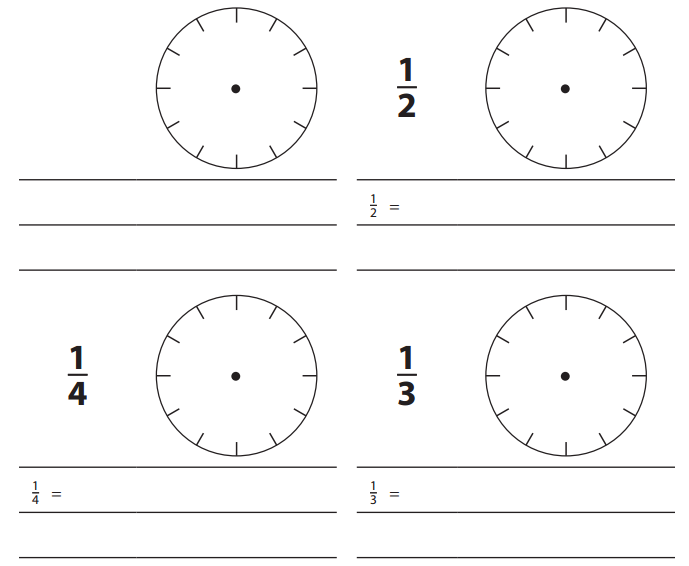
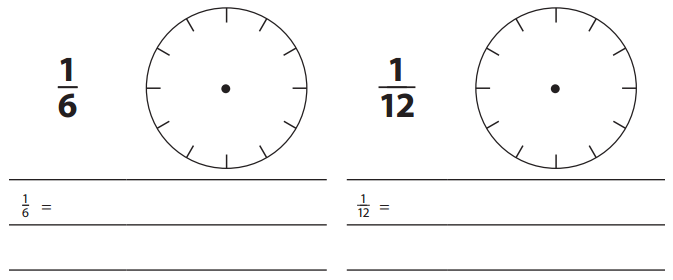
Answer:
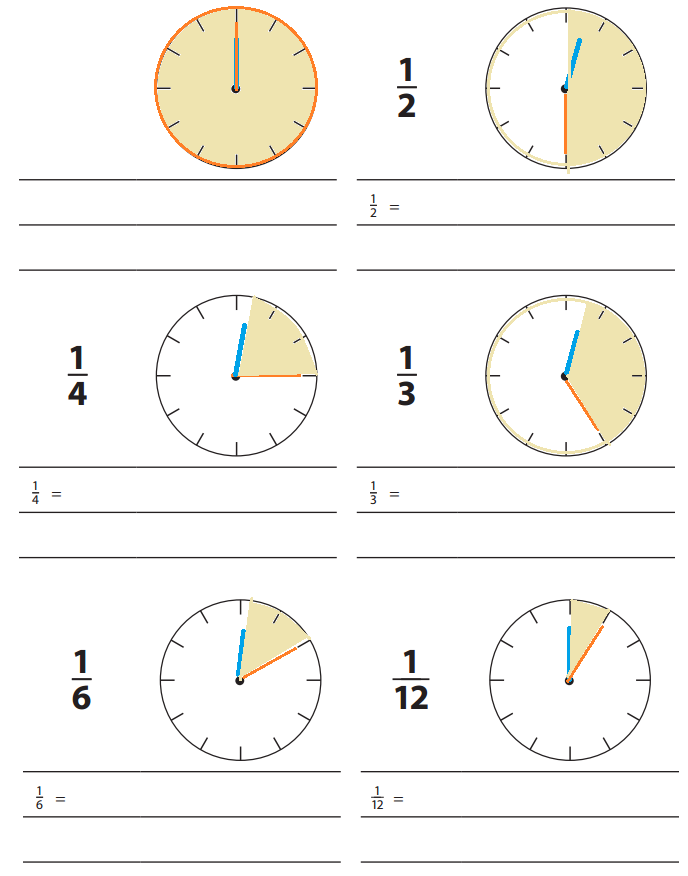
Explanation:
With reference to the Fractions on a Clock Face shown above,
\(\frac{1}{4}\) of a clock means, the whole clock is divided into 4 parts and \(\frac{1}{4}\) of
the fraction is shown on the above clock face.
\(\frac{1}{3}\) of a clock means, the whole clock is divided into 3 parts and \(\frac{1}{3}\) of
the fraction is shown on the above clock face.
\(\frac{1}{6}\) of a clock means, the whole clock is divided into 6 parts and \(\frac{1}{6}\) of
the fraction is shown on the above clock face.
\(\frac{1}{12}\) of a clock means, the whole clock is divided into 12 parts and \(\frac{1}{12}\) of the fraction is shown on the above clock face.
Clock Face Fractions
Question 1.
Color in the clock to show the fractions below. Each clock represents 1 whole.
a. \(\frac{1}{2}\)

Answer:
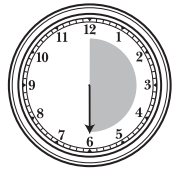
Explanation:
With reference to the above given information,
Each clock represents 1 whole.
\(\frac{1}{2}\) of a clock means, the whole clock is divided into 2 parts and \(\frac{1}{2}\) of
the fraction is shaded and shown on the above clock face.
b. \(\frac{1}{4}\)

Answer:
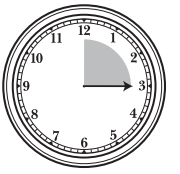
Explanation:
With reference to the above given information,
Each clock represents 1 whole.
\(\frac{1}{4}\) of a clock means, the whole clock is divided into 4 parts and \(\frac{1}{4}\) of
the fraction is shaded and shown on the above clock face.
c. \(\frac{2}{6}\)

Answer:
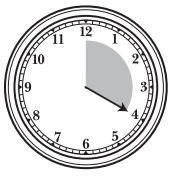
Explanation:
With reference to the above given information,
Each clock represents 1 whole.
\(\frac{2}{6}\) of a clock means, the whole clock is divided into 6 parts and \(\frac{2}{6}\) of
the fraction is shaded and shown on the above clock face.
d. \(\frac{10}{6}\)
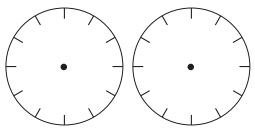
Answer:
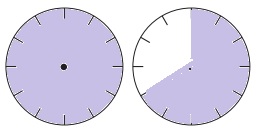
\(\frac{10}{6}\) is shaded.
Explanation:
With reference to the above given information,
Each clock represents 1 whole.
\(\frac{10}{6}\) = 1\(\frac{4}{6}\)
Each clock is divided into 6 parts.
the fraction of the clock is 1\(\frac{4}{6}\) is shaded as shown on the above clock face.
e. \(\frac{5}{3}\)
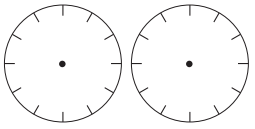
Answer:

\(\frac{5}{3}\) is shaded.
Explanation:
With reference to the above given information,
Each clock represents 1 whole.
\(\frac{5}{3}\) = 1\(\frac{2}{3}\)
Each clock is divided into 3 parts.
the fraction of the clock is 1\(\frac{2}{3}\) is shaded as shown on the above clock face.
Question 2.
Use the pictures above to help complete each comparison below using <, >, or =.
ex \(\frac{1}{2}\) > \(\frac{5}{12}\)
a. \(\frac{6}{4}\) 1\(\frac{1}{2}\)
Answer:
\(\frac{6}{4}\) = 1\(\frac{1}{2}\)
Explanation:
Given,
\(\frac{6}{4}\) = 1\(\frac{1}{2}\)
\(\frac{6}{4}\) = \(\frac{3}{2}\)
To equalize the denominators on both sides multiply with 2.
\(\frac{6}{4}\) = \(\frac{3×2}{2×2}\)
\(\frac{6}{4}\) = \(\frac{6}{4}\)
b. \(\frac{5}{6}\) \(\frac{5}{12}\)
Answer:
\(\frac{5}{6}\) > \(\frac{5}{12}\)
Explanation:
Given,
\(\frac{5}{6}\) \(\frac{5}{12}\)
To equalize the denominators on both sides multiply with 2.
\(\frac{5×2}{6×2}\) \(\frac{5}{12}\)
\(\frac{10}{12}\) > \(\frac{5}{12}\)
c. \(\frac{10}{6}\) 1\(\frac{1}{2}\)
Answer:
\(\frac{10}{6}\) > \(\frac{9}{6}\)
Explanation:
Given,
\(\frac{10}{6}\) = 1\(\frac{1}{2}\)
\(\frac{10}{6}\) = \(\frac{3}{2}\)
To equalize the denominators on both sides multiply with 3.
\(\frac{6}{4}\) = \(\frac{3×3}{2×3}\)
\(\frac{10}{6}\) > \(\frac{9}{6}\)
d. \(\frac{6}{2}\) \(\frac{6}{4}\)
Answer:
\(\frac{12}{4}\) > \(\frac{6}{4}\)
Explanation:
Given,
\(\frac{6}{2}\) = \(\frac{6}{4}\)
To equalize the denominators on both sides multiply with 2.
\(\frac{6×2}{2×2}\) = \(\frac{6}{4}\)
\(\frac{12}{4}\) > \(\frac{6}{4}\)
e. \(\frac{3}{6}\) \(\frac{2}{3}\)
Answer:
\(\frac{3}{6}\) \(\frac{2}{3}\)
Explanation:
Given,
\(\frac{3}{6}\) = \(\frac{2}{3}\)
To equalize the denominators on both sides multiply with 2.
\(\frac{3}{6}\) = \(\frac{2×2}{3×2}\)
\(\frac{3}{6}\) < \(\frac{4}{6}\)
Question 3.
Subtract these fractions. (Hint: Think about money or clocks to help.)
a. \(\frac{1}{2}\) – \(\frac{1}{4}\) = ______
Answer:
\(\frac{1}{4}\)
Explanation:
Given,
\(\frac{1}{2}\) – \(\frac{1}{4}\)
Equalize the denominators on both sides.
\(\frac{1×2}{2×2}\) – \(\frac{1}{4}\)
\(\frac{2}{4}\) – \(\frac{1}{4}\)
we know that when when denominators are same subtract the numerators.
\(\frac{2-1}{4}\) = \(\frac{1}{4}\)
b. \(\frac{3}{4}\) – \(\frac{1}{10}\) = ______
Answer:
\(\frac{13}{20}\)
Explanation:
Given,
\(\frac{3}{4}\) – \(\frac{1}{10}\)
Equalize the denominators on both sides.
\(\frac{3×5}{4×5}\) – \(\frac{1×2}{10×2}\)
\(\frac{15}{20}\) – \(\frac{2}{20}\)
we know that when when denominators are same subtract the numerators.
\(\frac{15-2}{20}\) = \(\frac{13}{20}\)
c. 1 – \(\frac{1}{6}\) = ______
Answer:
\(\frac{5}{6}\)
Explanation:
Given,
1 – \(\frac{1}{6}\)
\(\frac{(1×6)-1}{6}\) = \(\frac{6-1}{6}\) = \(\frac{5}{6}\)
d. 2 – 1\(\frac{1}{4}\) = ______
Answer:
\(\frac{3}{4}\)
Explanation:
Given,
2 – 1\(\frac{1}{4}\)
Convert mixed fraction to improper fraction.
2 – \(\frac{5}{4}\) = \(\frac{(2×4)-5}{4}\) = \(\frac{8-5}{4}\) = \(\frac{3}{4}\)
Question 4.
A certain fraction is greater than 2. The denominator is 8. What must be true about the numerator? Explain your answer.
![]() The numerator must be greater than ____ because:
The numerator must be greater than ____ because:
Answer:
The numerator must be greater than 16.
Explanation:
Given that, a certain fraction is greater than 2.
Thus, if the numerator and denominator are x and y respectively, then we have;
\(\frac{x}{y}\) > 2
We are further told that the denominator is 8.
Thus; \(\frac{x}{8}\) > 2
Multiply both sides by 8 to give;
x > 16
Hence, the numerator must be greater than 16.
Bridges in Mathematics Grade 5 Student Book Unit 2 Module 1 Session 4 Answer Key
Clock Fractions Problem String
Problem 1: ___________

Answer:
Problem 2: ________

Answer:
Problem 3: ________

Answer:
Problem 4: ________

Answer:
Problem 5: ________
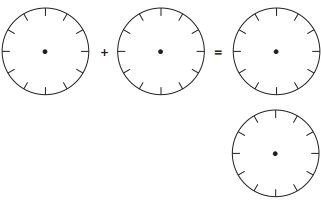
Answer:
Problem 6: ________
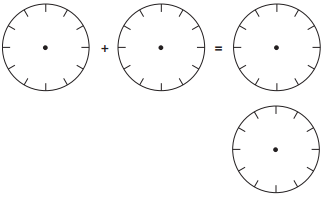
Answer:
Bridges in Mathematics Grade 5 Student Book Unit 2 Module 1 Session 4 Answer Key
Work Place Instructions 2A Clock Fractions
Each pair of players needs:
- Two 2A Clock Fractions Record Sheets
- 1 spinner overlay
- colored pencils in several colors
- regular pencils
1. Player 1 spins both spinners and writes the two fractions as an addition expression under the words “Equations for Each Turn.”
2. Then Player 1
- shades in both fractions on his first clock, using a different color for each fraction.
- labels each fraction
- records the sum of the two fractions to finish the equation for that turn.
Three fourths is the same as nine twelfths, so I’m shading in nine twelfths red. One sixth is the same as two twelfths, so I’m shading in two twelfths green. These two shaded parts add up to eleven twelfths, so 3/4 + 1/6 = 11/12.
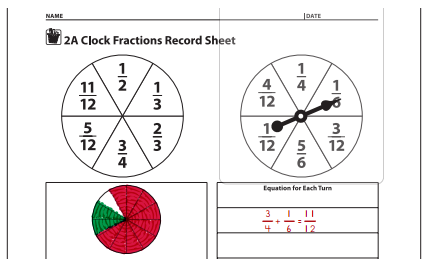
3. Both players check the work to make sure that Player 1 shaded and labeled the fractions and wrote the equation correctly.
4. Player 2 takes her turn and both players check her work.
5. Players do not move on to the next clock until a clock is completely filled. However, if a clock is nearly filled and a player spins a fraction that is too big for it, the player can split the fraction to complete the first clock and put the rest of the fraction in the next clock.
6. When a clock is completely filled, players write an equation that shows the fractions in the clock on the line underneath the clock.
7. The first player to completely fill all three clocks wins the game.
If a player spins a fraction that is too big for the third clock, she loses that turn. Players must fill the last clock with the exact fraction needed. For example, if a player’s third clock has 1/12 to fill in, the player has to spin 1/12 to complete the clock.
Game Variations
A. Players can shorten the game by filling only two clocks or lengthen the game by drawing another clock.
B. Players can work together to complete one record sheet, discussing each move and representation.
Bridges in Mathematics Grade 5 Student Book Unit 2 Module 1 Session 4 Answer Key
Adding Fractions
Question 1.
Show the fractions on the strips. Then add them and report the sum.

Answer:

Explanation:
With reference to the above given picture,
\(\frac{3}{4}\) + \(\frac{3}{4}\)
when denominators are same add the numerators,
\(\frac{6}{4}\) = \(\frac{3}{2}\)
Simplify as, 1\(\frac{1}{2}\)

Answer:

Explanation:
With reference to the above given picture,
\(\frac{3}{8}\) + \(\frac{1}{2}\)
first equalize the denominators by multiply by 4.
\(\frac{3}{8}\) + \(\frac{1×4}{2×4}\)
\(\frac{3}{8}\) + \(\frac{4}{8}\)
when denominators are same add the numerators,
\(\frac{3 + 4}{8}\) = \(\frac{7}{8}\)

Answer:

Explanation:
With reference to the above given picture,
\(\frac{5}{8}\) + \(\frac{3}{4}\)
first equalize the denominators by multiply by 2.
\(\frac{5}{8}\) + \(\frac{3×2}{4×2}\)
\(\frac{5}{8}\) + \(\frac{6}{8}\)
when denominators are same add the numerators,
\(\frac{5 + 6}{8}\) = \(\frac{11}{8}\) = 1\(\frac{3}{8}\)

Answer:

Explanation:
With reference to the above given picture,
\(\frac{1}{2}\) + \(\frac{7}{8}\)
first equalize the denominators by multiply by 4.
\(\frac{1×4}{2×4}\) + \(\frac{7}{8}\)
\(\frac{4}{8}\) + \(\frac{7}{8}\)
when denominators are same add the numerators,
\(\frac{4 + 7}{8}\) = \(\frac{11}{8}\) = 1\(\frac{3}{8}\)
Question 2.
Model each problem on a clock to add the fractions. Remember to label your work.
a. \(\frac{1}{2}\) + \(\frac{1}{6}\) =
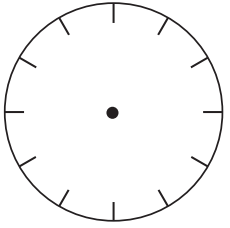
Answer:

Explanation:
Given,
\(\frac{1}{2}\) + \(\frac{1}{6}\)
first equalize the denominators by multiply by 3.
\(\frac{1×3}{2×3}\) + \(\frac{1}{6}\)
\(\frac{3}{6}\) + \(\frac{1}{6}\)
when denominators are same add the numerators,
\(\frac{3 + 1}{6}\) = \(\frac{4}{6}\) = \(\frac{2}{3}\)
Hence the clock is divided into 3 parts and 2/3 is shaded as shown above.
b. \(\frac{2}{3}\) + \(\frac{1}{6}\) =

Answer:

Explanation:
Given,
\(\frac{2}{3}\) + \(\frac{1}{6}\)
first equalize the denominators by multiply by 3.
\(\frac{2×3}{2×3}\) + \(\frac{1}{6}\)
\(\frac{6}{6}\) + \(\frac{1}{6}\)
when denominators are same add the numerators,
\(\frac{6 + 1}{6}\) = \(\frac{7}{6}\) = 1\(\frac{1}{6}\)
Hence, 1 whole and 1/6 is shaded as shown above.
c. \(\frac{1}{3}\) + \(\frac{2}{6}\) =
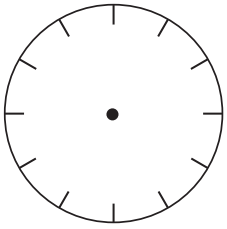
Answer:

Explanation:
Given,
\(\frac{1}{3}\) + \(\frac{2}{6}\)
first equalize the denominators by multiply by 2.
\(\frac{1×2}{3×2}\) + \(\frac{2}{6}\)
\(\frac{2}{6}\) + \(\frac{2}{6}\)
when denominators are same add the numerators,
\(\frac{2 + 2}{6}\) = \(\frac{4}{6}\) = \(\frac{2}{3}\)
Hence the clock is divided into 3 parts and 2/3 is shaded as shown above.
d. \(\frac{2}{3}\) + \(\frac{5}{6}\) =
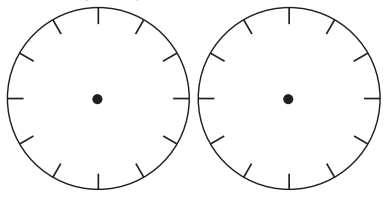
Answer:
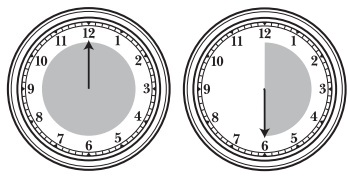
Explanation:
Given,
\(\frac{2}{3}\) + \(\frac{5}{6}\)
first equalize the denominators by multiply by 2.
\(\frac{2×2}{3×2}\) + \(\frac{5}{6}\)
\(\frac{4}{6}\) + \(\frac{5}{6}\)
when denominators are same add the numerators,
\(\frac{4 + 5}{6}\) = \(\frac{9}{6}\) = 1\(\frac{3}{6}\)
Hence, 1 whole and 3/6 is shaded as shown above.
Bridges in Mathematics Grade 5 Student Book Unit 2 Module 1 Session 5 Answer Key
Equivalent Fractions on a Clock
This clock is broken! The hour hand is stuck at the 12, but the minute hand can still move.

Question 1.
Marcus looked at the clock shown above and said, “ \(\frac{1}{4}\) of an hour has passed.” Sierra said, “\(\frac{3}{12}\) of an hour has passed.” Ali said, “\(\frac{15}{60}\) of an hour has passed.” Their teacher said they were all correct. Explain how this could be possible.
Answer:
Yes, answers of the three were correct.
Explanation:
Marcus said, \(\frac{1}{4}\) of an hour has passed.
According to him hours clock is divided into 4 parts.
So, \(\frac{1}{4}\) of the time has passed.
Sierra said, \(\frac{3}{12}\) of an hour has passed.
According to her the 12 hours clock is divided into 12 parts.
So, \(\frac{3}{4}\) of the time has passed.
Ali said, \(\frac{15}{60}\) of an hour has passed.
We know that, 1 hour = 60 minutes.
So, \(\frac{15}{60}\) of the time has passed.
Hence, all are correct.
Question 2.
Label each clock with at least 3 equivalent fractions to show what part of an hour has passed.
a.
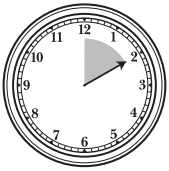
___ ____ ____
Answer:
\(\frac{1}{6}\) = \(\frac{2}{12}\) = \(\frac{3}{18}\)
Explanation:
With reference to the above information given, the clock shows \(\frac{1}{6}\)
The following are 3 equivalent fractions to show what part of an hour has passed.
\(\frac{1×2}{6×2}\) \(\frac{2}{12}\)
\(\frac{1×3}{6×3}\) \(\frac{3}{18}\)
b.
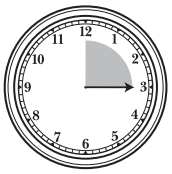
___ ____ ____
Answer:
\(\frac{1}{4}\) = \(\frac{2}{8}\) = \(\frac{3}{12}\)
Explanation:
With reference to the above information given, the clock shows \(\frac{1}{4}\)
The following are 3 equivalent fractions to show what part of an hour has passed.
\(\frac{1}{4}\) is written as:
\(\frac{1x 2}{4 x2}\) = \(\frac{2}{8}\)
\(\frac{1x 3}{4 x3}\) = \(\frac{3}{12}\)
c.

___ ____ ____
Answer:
\(\frac{1}{3}\) = \(\frac{2}{6}\) = \(\frac{3}{9}\)
Explanation:
With reference to the above information given, the clock shows \(\frac{1}{3}\)
The following are 3 equivalent fractions to show what part of an hour has passed.
\(\frac{1}{3}\) is written as:
\(\frac{1x 2}{3 x2}\) = \(\frac{2}{6}\)
\(\frac{1x 3}{3 x3}\) = \(\frac{3}{9}\)
d.

___ ____ ____
Answer:
\(\frac{1}{2}\) = \(\frac{2}{4}\) = \(\frac{3}{6}\)
Explanation:
With reference to the above information given, the clock shows \(\frac{1}{2}\)
The following are 3 equivalent fractions to show what part of an hour has passed.
\(\frac{1}{2}\) is written as:
\(\frac{1x 2}{2 x2}\) = \(\frac{2}{4}\)
\(\frac{1x 3}{2 x3}\) = \(\frac{3}{6}\)
e.

___ ____ ____
Answer:
\(\frac{2}{3}\) = \(\frac{4}{6}\) = \(\frac{6}{9}\)
Explanation:
With reference to the above information given, the clock shows \(\frac{2}{3}\)
The following are 3 equivalent fractions to show what part of an hour has passed.
\(\frac{2}{3}\) is written as:
\(\frac{2x 2}{3 x2}\) = \(\frac{4}{6}\)
\(\frac{2x 3}{3 x3}\) = \(\frac{6}{9}\)
f.

___ ____ ____
Answer:
\(\frac{3}{4}\) = \(\frac{6}{8}\) = \(\frac{9}{12}\)
Explanation:
With reference to the above information given, the clock shows \(\frac{3}{4}\)
The following are 3 equivalent fractions to show what part of an hour has passed.
\(\frac{3}{4}\) is written as:
\(\frac{3x 2}{4 x2}\) = \(\frac{6}{8}\)
\(\frac{3x 3}{4 x3}\) = \(\frac{9}{12}\)
g.
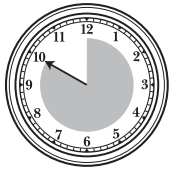
___ ____ ____
Answer:
\(\frac{10}{12}\) = \(\frac{5}{6}\) = \(\frac{15}{18}\)
Explanation:
With reference to the above information given, the clock shows \(\frac{10}{12}\)
The following are 3 equivalent fractions to show what part of an hour has passed.
\(\frac{10}{12}\) is written as:
\(\frac{10 ÷ 2}{12 ÷2}\) = \(\frac{5}{6}\)
\(\frac{5x 3}{6 x3}\) = \(\frac{15}{18}\)
h.
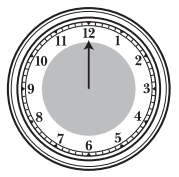
___ ____ ____
Answer:
\(\frac{12}{12}\) = \(\frac{1}{1}\) = \(\frac{2}{2}\)
Explanation:
With reference to the above information given, the clock shows \(\frac{12}{12}\)
The following are 3 equivalent fractions to show what part of an hour has passed.
\(\frac{12}{12}\) is written as:
\(\frac{1x 1}{1 x1}\) = \(\frac{1}{1}\)
\(\frac{1x 2}{1 x2}\) = \(\frac{2}{2}\)